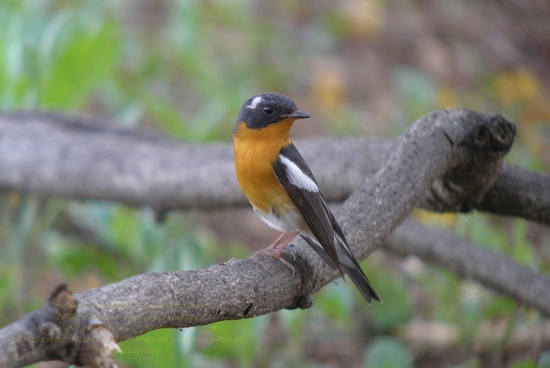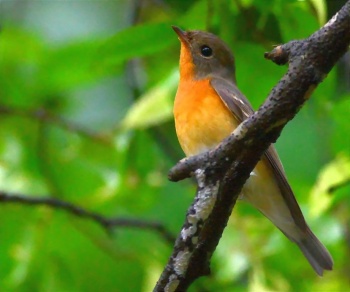m |
(→External Links: Additional GSearch for common name. Video link deleted as no longer available. GSearch checked template) |
||
| (11 intermediate revisions by 4 users not shown) | |||
| Line 1: | Line 1: | ||
| − | + | [[Image:Mugmaki FC 3.jpg|thumb|550px|right|Photo © by {{user|mohbhorn|mohbhorn}}<br /> Vachirabenjatas Park, Bangkok, [[Thailand]]]] | |
| − | [[Image: | ||
'''Alternative name: Robin Flycatcher''' | '''Alternative name: Robin Flycatcher''' | ||
;[[:Category:Ficedula|Ficedula]] mugimaki | ;[[:Category:Ficedula|Ficedula]] mugimaki | ||
| − | |||
==Identification== | ==Identification== | ||
| − | + | [[Image:Filtered ND4 0087 Medium .JPG|thumb|350px|right|Female<br />Photo © by {{user|jweeyh|jweeyh}}<br />[[Singapore]], December 2018]] | |
| + | 12·5–13·5 cm (5-5¼ in) | ||
| + | *Black upperparts | ||
| + | *Short white [[Topography#Heads|supercilium]] | ||
| + | *White wing-patch | ||
| + | *White edges to the [[Topography#Wings|tertials]] | ||
| + | *White at the base of the outer tail-feathers | ||
| + | *Orange red breast and throat | ||
| + | *White belly and undertail-[[Topography#General Anatomy|coverts]]<br /> | ||
| + | '''Female''' | ||
| + | *Grey-brown above | ||
| + | *Pale orange-brown breast and throat | ||
| + | *No white in the tail | ||
| + | *One or two pale wingbars | ||
| + | *Faint or absent supercilium<br /> | ||
| + | '''Young males'''<br /> | ||
| + | *Similar to the female but have a brighter orange breast, white in the tail and a more obvious supercilium. | ||
| + | ==Distribution== | ||
| + | Eastern [[Asia]]; breeding from central-southern [[Siberia]] east to north-eastern [[China]] and Sakhalin, and migrating to southern China, [[Vietnam]], [[Laos]], [[Singapore]], [[Malaysia]] and [[Indonesia]] in winter; also frequent on migration in [[Korea]], [[Japan]] and [[Thailand]]. | ||
| − | + | Accidental vagrant to [[Alaska]] with 1 record. | |
| − | |||
==Taxonomy== | ==Taxonomy== | ||
| + | This is a [[Dictionary_M-S#M|monotypic]] species<sup>[[#References|[1]]]</sup>. | ||
==Habitat== | ==Habitat== | ||
| − | + | They breed in submontane broadleaf and conifer forests | |
==Behaviour== | ==Behaviour== | ||
| − | + | ====Diet==== | |
| + | Primarily insects; rarely also berries and seeds. | ||
| + | ==References== | ||
| + | #{{Ref-Clements6thAug18}}#Handbook of the Birds of the World Alive (retrieved December 2014) | ||
| + | {{ref}} | ||
==External Links== | ==External Links== | ||
| + | Search the Gallery using the scientific name: | ||
{{GSearch|Ficedula+mugimaki}} | {{GSearch|Ficedula+mugimaki}} | ||
| − | [[Category:Birds | + | Search the Gallery using the common name: |
| + | {{GSearch|"Mugimaki Flycatcher"}} | ||
| + | {{GS-checked}} | ||
| + | <br /> | ||
| + | <br /> | ||
| + | |||
| + | [[Category:Birds]] [[Category:Ficedula]] | ||
Latest revision as of 21:18, 12 March 2022
Alternative name: Robin Flycatcher
- Ficedula mugimaki
Identification
12·5–13·5 cm (5-5¼ in)
- Black upperparts
- Short white supercilium
- White wing-patch
- White edges to the tertials
- White at the base of the outer tail-feathers
- Orange red breast and throat
- White belly and undertail-coverts
Female
- Grey-brown above
- Pale orange-brown breast and throat
- No white in the tail
- One or two pale wingbars
- Faint or absent supercilium
Young males
- Similar to the female but have a brighter orange breast, white in the tail and a more obvious supercilium.
Distribution
Eastern Asia; breeding from central-southern Siberia east to north-eastern China and Sakhalin, and migrating to southern China, Vietnam, Laos, Singapore, Malaysia and Indonesia in winter; also frequent on migration in Korea, Japan and Thailand.
Accidental vagrant to Alaska with 1 record.
Taxonomy
This is a monotypic species[1].
Habitat
They breed in submontane broadleaf and conifer forests
Behaviour
Diet
Primarily insects; rarely also berries and seeds.
References
- Clements, J. F., T. S. Schulenberg, M. J. Iliff, D. Roberson, T. A. Fredericks, B. L. Sullivan, and C. L. Wood. 2018. The eBird/Clements checklist of birds of the world: v2018. Downloaded from http://www.birds.cornell.edu/clementschecklist/download/
- Handbook of the Birds of the World Alive (retrieved December 2014)
Recommended Citation
- BirdForum Opus contributors. (2024) Mugimaki Flycatcher. In: BirdForum, the forum for wild birds and birding. Retrieved 28 May 2024 from https://www.birdforum.net/opus/Mugimaki_Flycatcher
External Links
Search the Gallery using the scientific name:
Search the Gallery using the common name:
GSearch checked for 2020 platform.





